Have you ever wondered if you could infuse your favorite heart-healthy cooking oil with cannabis? Learn how to make a delicious cannabis olive oil at home with just a crockpot or slow cooker. This recipe is perfect for anyone who wants to learn how to make a dairy-free, plant-based cannabis oil that can be used in many different recipes.
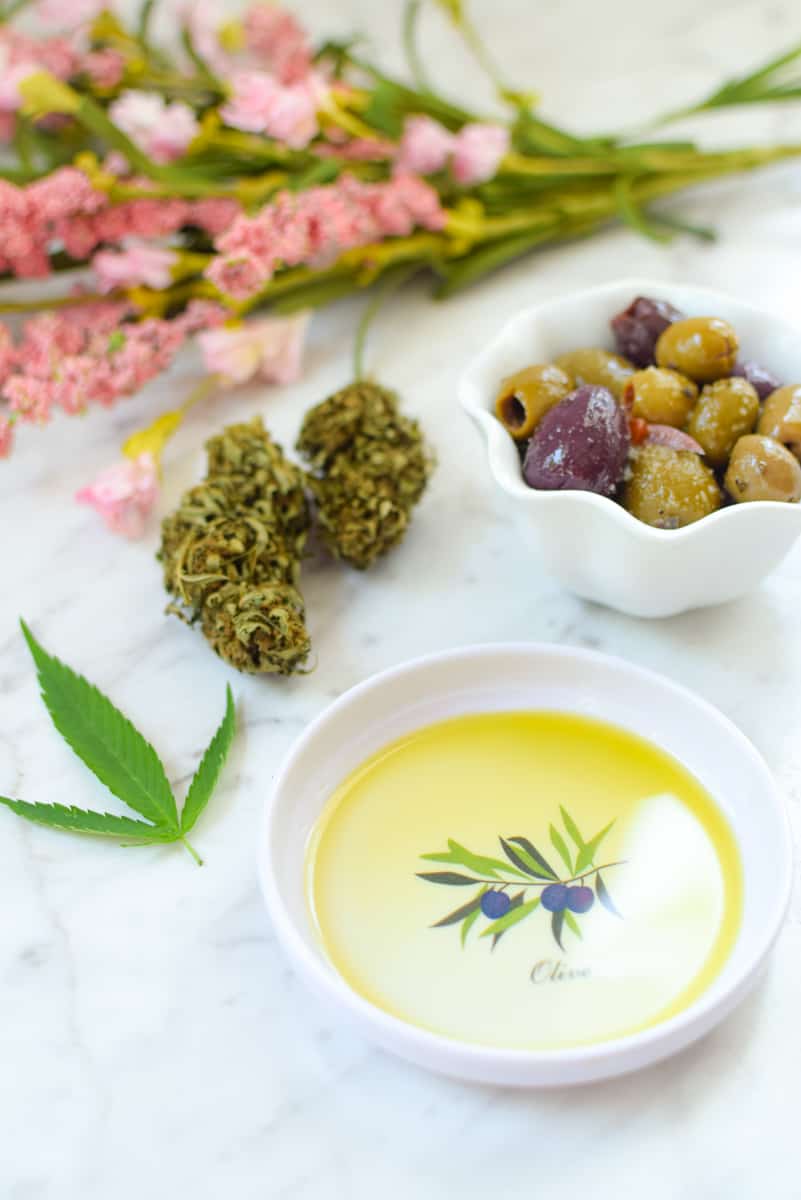
Table of Contents
Recipe Features
- A fan favorite with over 50+ 5 star reviews!
- No special equipment required! You just need a basic crockpot or Instant pot
- Want to make it easy? Skip the hard work, order my Bliss MCT Oil, and have it delivered straight to your door – now shipping across the United States!

Why You Will Love This Recipe
Cannabis olive oil is a light, delicious, and versatile infusion that is an important staple recipe for my Well With Cannabis Community members.
This oil can also serve as a vegan cannabutter alternative, alongside coconut oil and MCT oil.
After making your own cannabis-infused olive oil, you will be able to use it to make many delicious recipes like our popular cannabis pesto and lemon vinaigrette.
Here I will teach you how to infuse cannabis olive oil with my easy step-by-step guide, notes, expert tips, and fully answered FAQs below.
Ingredient Notes
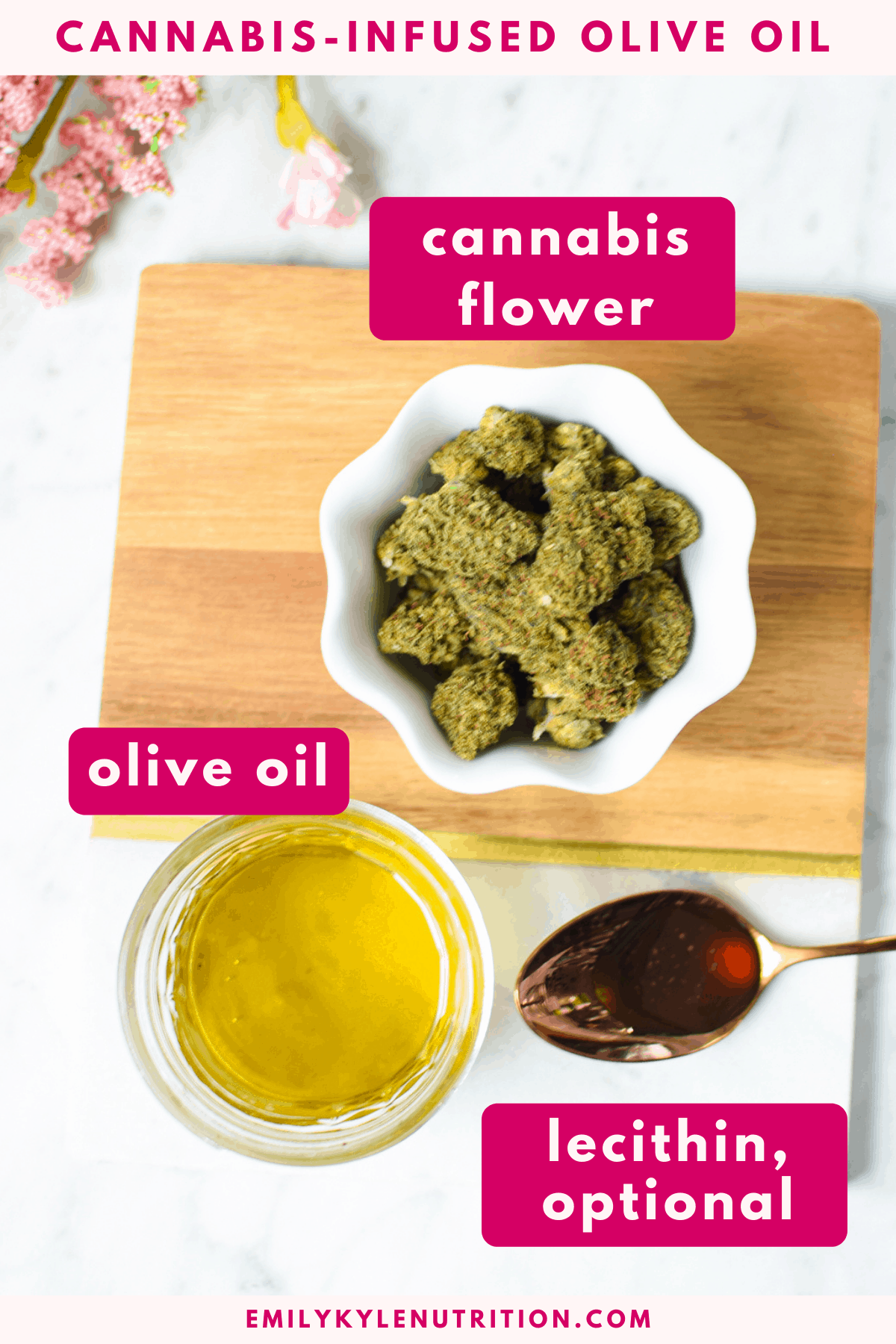
- Olive Oil – Extra-virgin olive oil is great because it is delicious and versatile.
- Cannabis Flowers – You will need your desired amount of cannabis flowers, ranging from 3.5 grams up to 1 ounce. Use this ratio guide to determine how much flower to oil to use. Choose THC, CBD, or CBG flower. You can purchase from my online shop here.
- Lecithin, optional: If you’re new to working with lecithin, you can learn more about adding lecithin to edibles here. If needed, you can purchase liquid lecithin or powdered lecithin. This ingredient is optional.
Note: a complete list of ingredients with amounts and printable instructions is located in the recipe card below.
The Step-by-Step Process
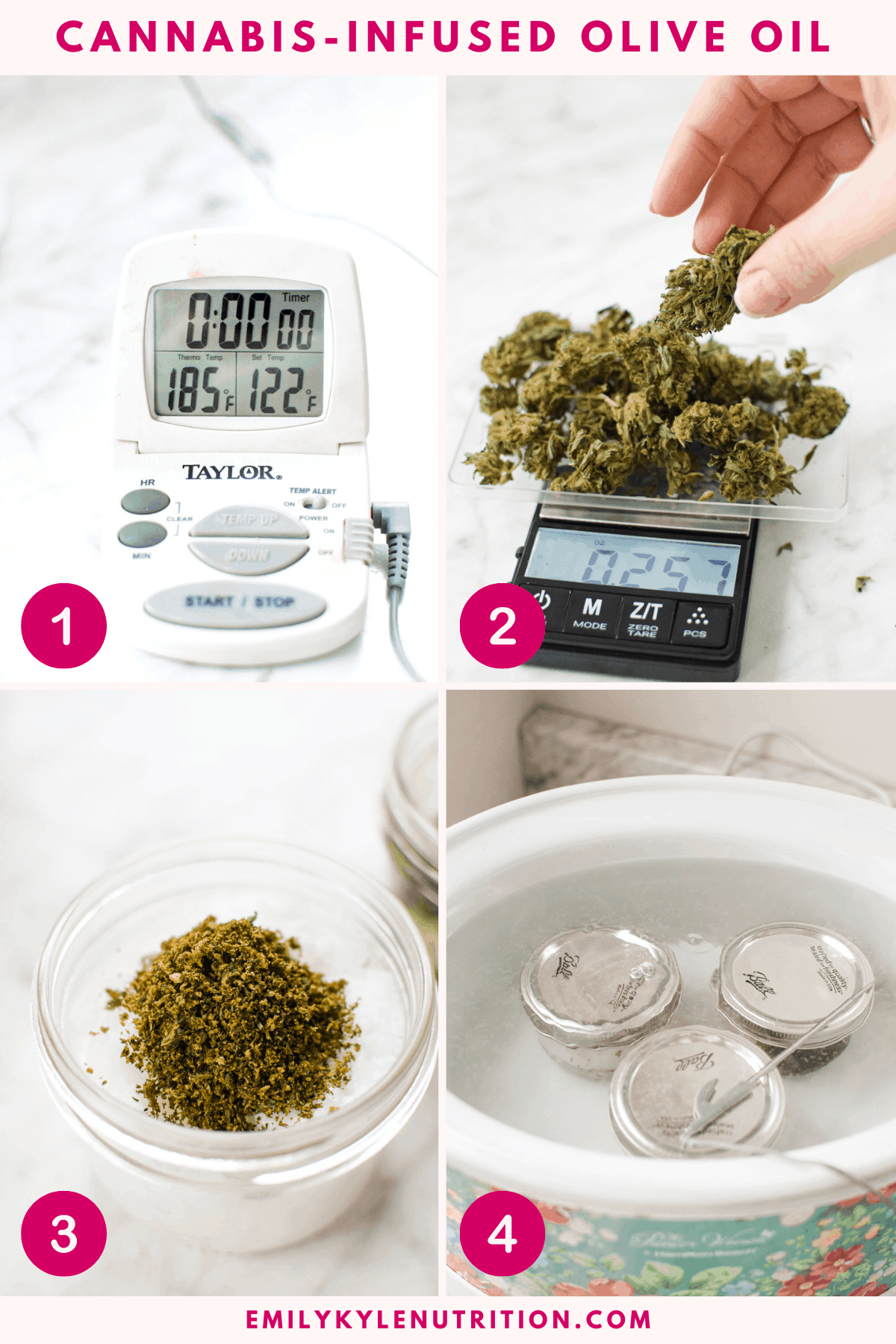
- Step 1 – Create a water bath that stays at approximately 180-190° F. The printable instructions below are for using a crockpot.
- Step 2 – While the water bath is heating, measure and decarb your cannabis flower. Use my traditional oven or Instant pot decarboxylation tutorials, if needed.
- Step 3 – Evenly add the decarbed flower and olive oil to the mason jars you plan on using. If you plan on using lecithin, add it now.
- Step 4 – Place the jars into the water bath. Place the lid on the crockpot and leave it alone to infuse for 4 hours. After 4 hours, remove the jars from the water and allow them to cool.
The Step-By-Step Process
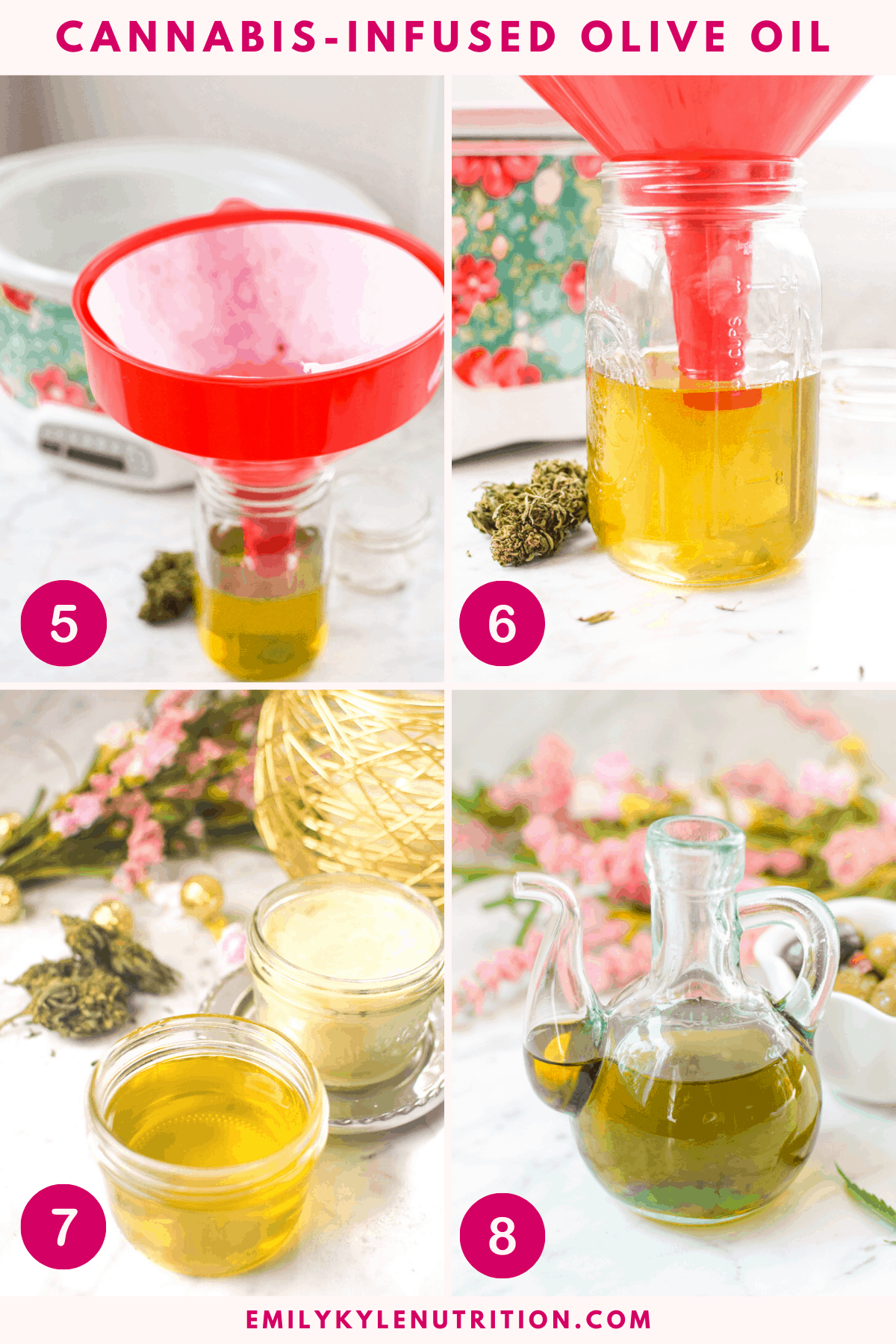
- Step 5 – Set up a straining station to separate the plant matter from the oil. Options include a paper filter and funnel, cheesecloth, French press, or a simple coffee filter.
- Step 6 – Strain the oil . You can save the leftover cannabis pulp for use in future recipes.
- Step 7 – Return the prepared oil to whatever jar you would like to store it in; a mason jar works well.
- Step 8 – Store the oil in a cool, dry place. It will last longer if stored in the refrigerator and even longer if stored in the freezer.
Note: complete step-by-step printable instructions are located in the recipe card below.
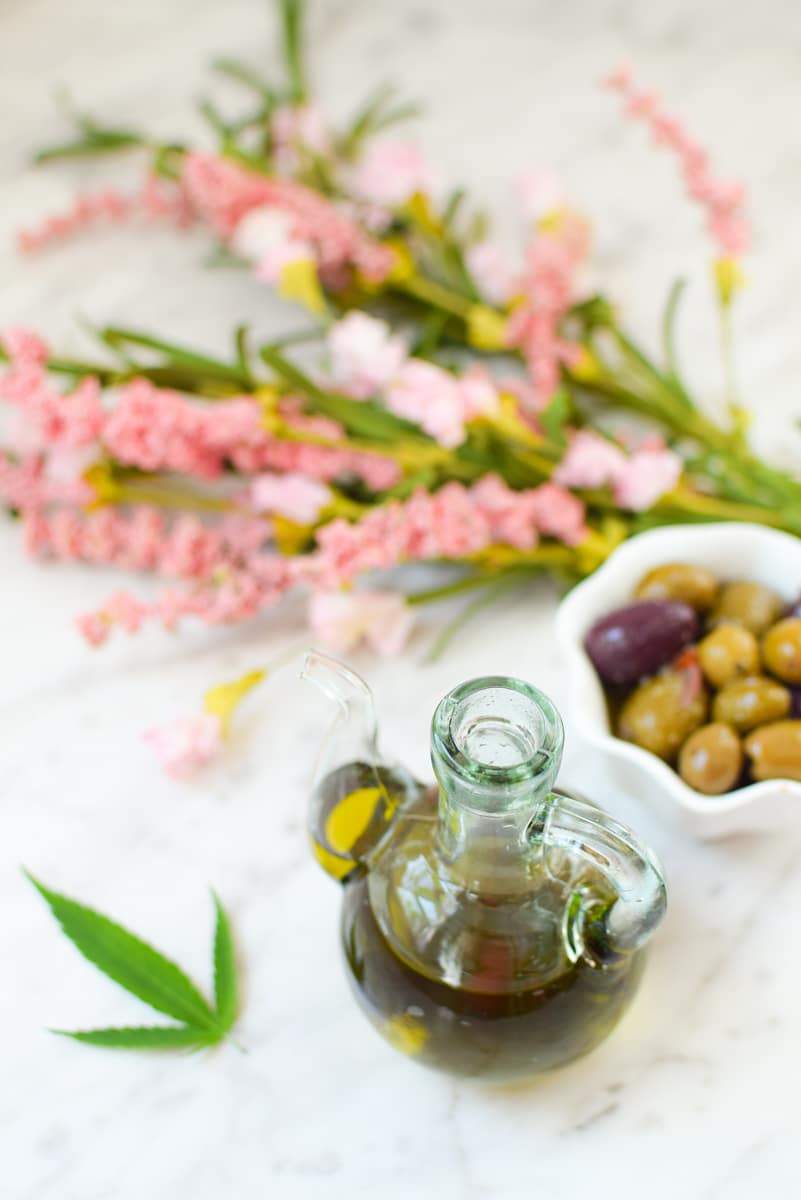
Olive Oil For Good Health
Extra-virgin olive oil (EVOO) is widely known as one of the world’s healthiest oils.1
So much so that people tend to live longer and healthier lives in areas where olive oil is a staple part of the diet.
Like hemp seeds and hemp seed oil, EVOO has a high percentage of omega-3 fatty acids. According to the FDA, having two tablespoons of EVOO daily may reduce your heart disease risk.2
EVOO is also extremely rich in antioxidants. It contains polyphenols which act as antioxidants by reducing oxidative stress throughout your body.
Antioxidants also aid in strengthening your immune system, making your body more resistant to infections and inflammation.3
Notes & Expert Tips
Below is a general guideline explaining the most important steps you need to take to make cannabis olive oil at home.
SAVE THIS GUIDE 💌
Decarb First
To reap the benefits of CBD or THC, you must decarboxylate the cannabis before combining it with the oil. This process is as simple as heating it in the oven.
For this recipe, we decarb our cannabis flower in the oven before combining it with the olive oil and placing it into the crockpot. Therefore, we can have a shorter infusion time, a total of four hours.
If you’re brand new to the process of decarboxylation, start with my guide for decarbing in an oven or an Instant Pot.
Consider the Strain You’re Using
Each cannabis strain contains varying amounts and ratios of different cannabinoids and terpenes.
Because each cannabinoid and terpene decarboxylates at a different temperature, you will want to consider the best temperature and cooking time for your particular strain.
Additionally, the final potency and intoxicating effects will vary depending on THC or CBD dominant strain.
The Freshness of Product
You notice differences in your final product depending on the freshness of the material you start with.
You can use traditionally dried and cured flower, raw flower buds or trim. If you use raw trim, just know your final product will look and taste more green, due to the extra chlorophyll.
The potency will vary with the freshness of the material, the cannabinoid concentration, and how much you ultimately use.
Save The Leftover Pulp
After the straining process, you will be leftover with a ball of spent cannabis flower, also called leftover pulp or sludge.
While some folks say it is garbage and throw it away, I’ve heard too many success stories of people using the pulp with great results.
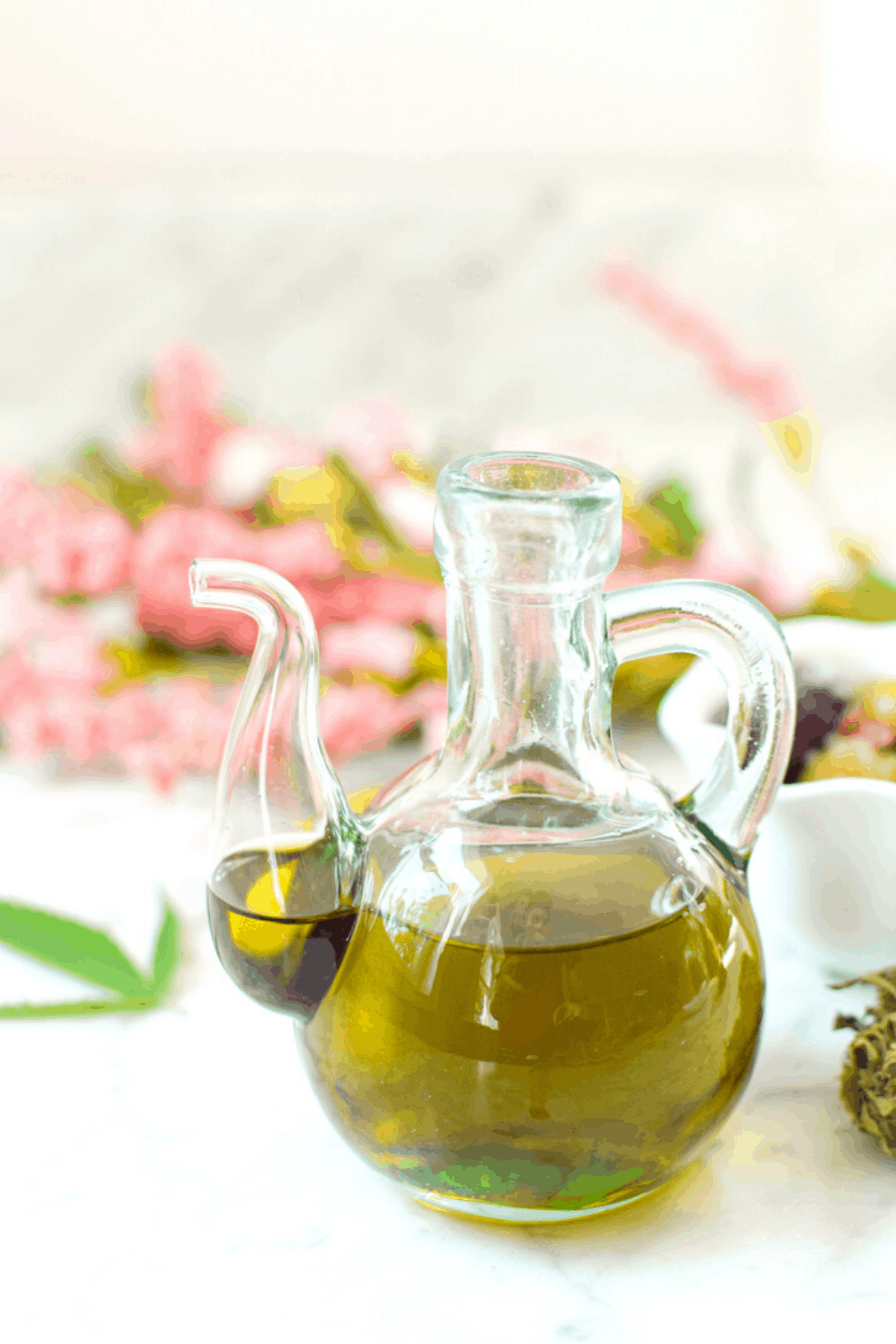
Anecdotally, many members of my Well With Cannabis Community have reported still receiving pleasant, intoxicating high effects when consuming the pulp.
This supports the theory that at least some percentage of cannabinoids are left behind in the plant matter.
I believe in both nutrition and sustainability, so I recommend keeping your leftover pulp to use in any one of these 15 ways to use leftover cannabis pulp.
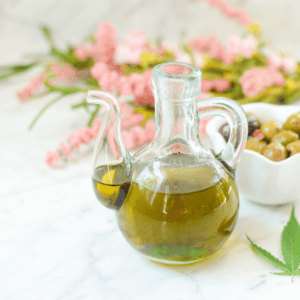
Easy Crockpot Cannabis Olive Oil Recipe
Ingredients
- 16 ounces extra-virgin olive oil
- 1 ounce decarbed cannabis flower
Instructions
- Lay a clean tea towel down on the bottom of the crockpot. This will create a buffer between your mason jars and the crockpot, potentially preventing any jar from moving or cracking during cooking. Fill your crockpot with enough warm to hot water to cover the top of the mason jars you plan on using by an inch to create a water bath.
- Place the digital instant-read thermometer into the water. Start the crockpot heat on high. When a temperature of 185° F is reached, turn the crockpot to low.
- While the water bath is heating in the crockpot, measure and decarb the cannabis flower according to the appropriate decarb time and temperature.
- Evenly divide the olive oil between the mason jars you plan on using. You can either use pint-sized or half-pint-sized jars, it's you're preference, just be sure they fit in your crockpot. No matter the size, be sure to leave a 1/2 inch headspace from the top.
- Evenly divide the decarbed flower between the olive oil-filled jars. Wipe the rim of the jars with a clean towel and place the lid on. Tighten the metal ring to finger-tip tightness; it does not have to be tightened all the way. Do not tighten too tightly.
- Once the water bath reaches a temperature of 185° F, carefully place the jars into the water bath. Place the lid on the crockpot and leave it alone to infuse for 4 hours.
- After 4 hours, carefully remove the lid, followed by the jars from the hot water. Set them aside to cool.
- Once cool enough to handle, you will want to strain the oil through a paper filter and funnel, cheesecloth, or French press to separate the plant-matter from the olive oil.
- Save the leftover cannabis pulp for use in future recipes. Then return the prepared cannabis olive oil to whatever jar you would like to store it in.
- Store the prepared cannabis olive oil in a cool, dry place. It will last longer if stored in the refrigerator and even longer if stored in the freezer.
Notes
- Yield: ~16 ounces / ~2 cups. You can make a smaller batch by following this ratio guide.
- Temperature control: The water bath does not need to stay perfectly at 185° F the whole time. Any temperature between 170°-190°F is OK.
- Safety: Sanitize your jars by keeping them submerged in the 185° F crockpot for 10 at least minutes. This step is not necessary, but good practice.
- Floating jars: The mason jar may float when placed in the water bath. Simply put something heat and water safe over the top of the jar to weigh it down, a clean rock works well.
- Alternative carrier oil options include: avocado oil, hemp seed oil, grape seed oil, coconut oil
Nutrition
Frequently Asked Questions
Yes, you can infuse olive oil with FECO or RSO. I recommend mixing 1mL of FECO with 29mL of olive oil for a strong batch, but you can choose to mix 1mL FECO with your desired oil amount.
Yes, you can easily scale this recipe to a smaller size to meet your needs. Simply use this cannabis flower to oil ratio guide to help you decide how much to infuse. The process of infusion will remain the same regardless of how much you use.

Take your edibles to the next level…
My Edibles Made Easy Online Cooking Course will teach you how to easily make cannabis edibles and topical recipes at home. This step-by-step video course will teach you how to infuse, extract, and create edibles with many different product types – all from the comfort of your own home.
More Guides You Will Love
All Things Cannabis Oil
The Best Carrier Oils for Cannabis Infusions
Articles & How-To Guides
Cannabis Flower-to-Oil Ratio Guide & Printable Chart
Cannabis Infusions & Extractions
Instant Pot Cannabutter or Oil » Easy Guide
Cannabis Infusions & Extractions
Easy Homemade CBD Oil Recipe


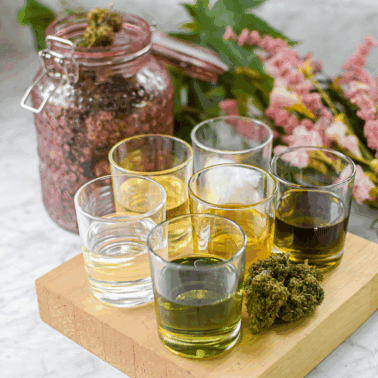
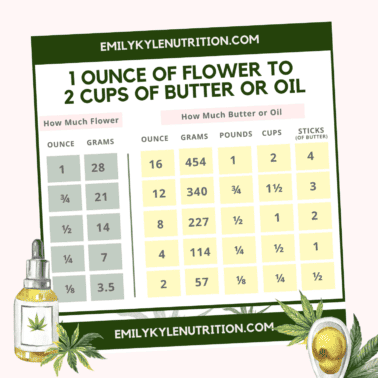
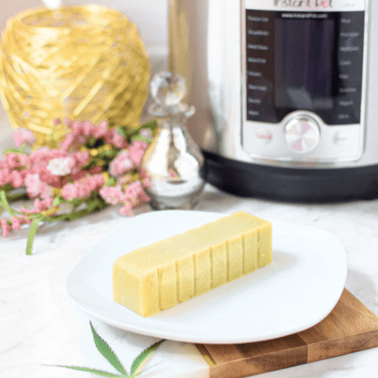
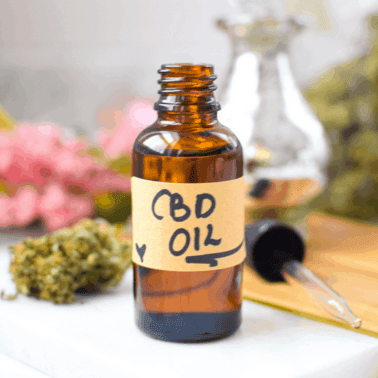
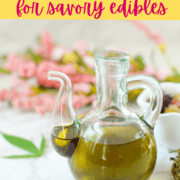








Hello from the UK Emily, first of all, your site is amazing and has helped me research THC olive oil, a thousand thank yous. I’ve followed all your instructions including decarb and currently I have mason jars with oil and bud in my crockpot/slow cooker at 185°F, can I cook for longer than 4 hours, I’m in no rush, would there be any benefit cooking for 6 hours?
One love
Andrew
Hi Andrew, thank you so much for your kind words—I’m thrilled the guide has been helpful! Cooking longer than 4 hours is totally fine, and while it may slightly increase infusion, most of the benefits are achieved within the 4-hour mark. After that, you’re mostly pulling other plant material into the infusion. Feel free to experiment, though — just keep the temperature steady. One love! 😊
Hi Emily
I made a salve and it came out smelling like weed really bad what should I do to fix it or should I say can I fix it?
I’m so happy you took the time to reach out, Duane! If your salve has a strong cannabis odor, you can try masking it by adding a few drops of essential oils like lavender or peppermint, which can help with both fragrance and benefits. Just be sure to mix well and test a small amount first. Let me know how it goes! 😊
Good day Emily and thanks for your recipes!!! I have a modified one, perhaps others would like it as well as it removes the need to filter, and leaves you with some left overs you can place in gel caps too. I decarb in the oven as you indicated, but before doing so open up a teabag, empty the contents and replace with the cannabis; saving the tea for a tea dropper later. Then I the place two staples in the tea bag to seal it after folding it over, and proceed with decarb. After decarb you can add your oil or your transferring agent if will and do either the crock pot or instant pot method to infuse. Note I have found that the low setting on crockpot for 8 hours does a better job as far as potency, but both work. The tea bag method eliminates the need to filter requirement and we have had great success with this method.
The other method is to simply sift your cannabis to a finer consistency, then decarb it per your instructions. Simply let it cool, and place in gelatin capsules, and she takes them directly; just as you would place it in brownies…etc. Since my wife suffers from advanced neuropathy this method works well if we require a quicker treatment. Thanks as always we could never have seen her pain free without your guidance, also thanks for the MCT advice too.
Hi there, Brad. Thank you so much for sharing your modified recipe and methods with us! It’s fantastic to hear from readers who have found creative ways to make the process easier and more efficient. Your tea bag method sounds very interesting – a great way to avoid filtering and make use of every bit of the cannabis 😄 Your alternative method of using sifted cannabis in gelatin capsules is also an innovative approach, and I’m thrilled to hear it’s providing quick relief for your wife’s neuropathy. Your feedback not only helps me, but also our entire community, and I’m sure many will find your feedback helpful. Thank you for being a part of our journey and for your kind words. It’s wonderful to know that the advice and recipes have been beneficial for you and your wife.
Excellent recipe. I am going to use it to make something I can just take a tsp of in the evening to help me sleep. What on earth do you do with the infusion poo that is left over? It must have lots of medicine left in it and I hate to waste it.
Hi Mary. That is an excellent question. The leftover pulp definitely has some use left. Check out Emily’s guide here for some ideas: 15 Best Ways To Use Leftover Cannabis Pulp. I hope this helps!
Can I put leaves and stems in crockpot without the mason jar? I use coconut oil and will cook for
Eight hours. Then use a cheese cloth to strain. Will this have a lot of thc? I want to make brownies and cookies
Hi Lori. Fan leaves and stems only have trace amounts of trichomes, so it is not likely there will be a lot of THC. There is more information here: The Anatomy of a Female Cannabis Plant I hope this helps!
Emily, can I use olive oil (instead of alcohol) to create a tincture to use sublingually? Thanks!
Hey Steve, yes, you sure can 😀
Could you use this under your tongue like a tincture?
Hello Freya, yes, you can 😀
Hi Emily…what size crock pot are you using? Thanks!
Hello Lea, the one I used here is a 7-quart crockpot 🙂
Interested in making this recipe but I purchased light olive oil so that it can be used for baking and cooking is that okay does anything need to change in the recipe considering it’s a light olive oil
Hey Michelle, no, I wouldn’t change a thing, just proceed as normal 😀
I haven’t tried the recipe yet but it was really easy to read through and I’m excited to try it. I do have a question… is it possible to follow this recipe without the water bath? I have a small crockpot (for making dips) and my first idea was to combine the oil and cannabis directly in the crockpot. Would this method not work?
Hey Christie! Yes, you could do it that way 🙂 You’ll just have a bit more of a mess to clean up at the end.
Emily, your website has some really great resources, and I am excited to try many of the recipes. Quick question.. was I supposed to grind up the decarb’d cannabis for this recipe? The instructions didn’t say, so after decarb, I mixed with oil as recommended. Now that it is undergoing the infusion process, I questioned if I missed something so I came back and re-read this article. I didn’t find any instructions one way or the other, but noticed the picture in process #3 looks like it may have been ground. Since the flower is popcorn size, I was wondering If I would get the full extraction/benefits. Was I supposed to grind? If it doesn’t really matter are there any advantages or disadvantages? I hope I didn’t mess up my first attempt 🙂
Thank you!
Hey Ed! You did exactly the right thing ? Leaving the buds in popcorn sized pieces is great. I avoid grinding my cannabis for infusions because you can lose a lot of the cannabinoids to the grinder, and the process releases more chlorophyll into the final infusion (which makes it look and taste green). I hope the final product turned out well ?